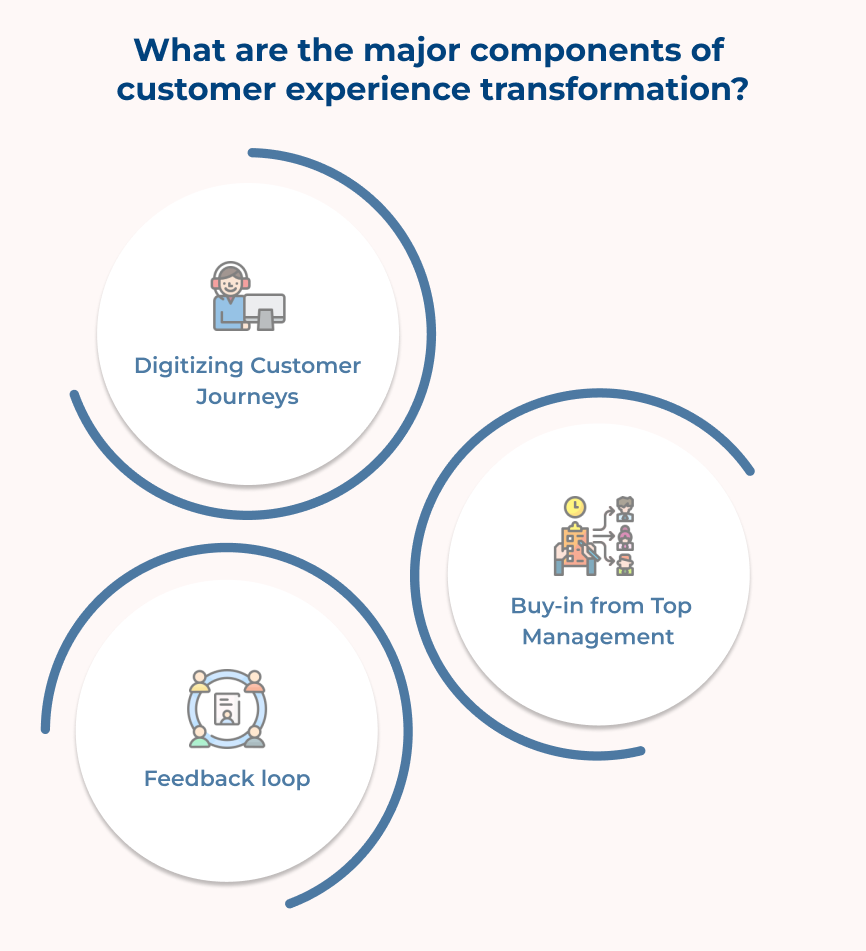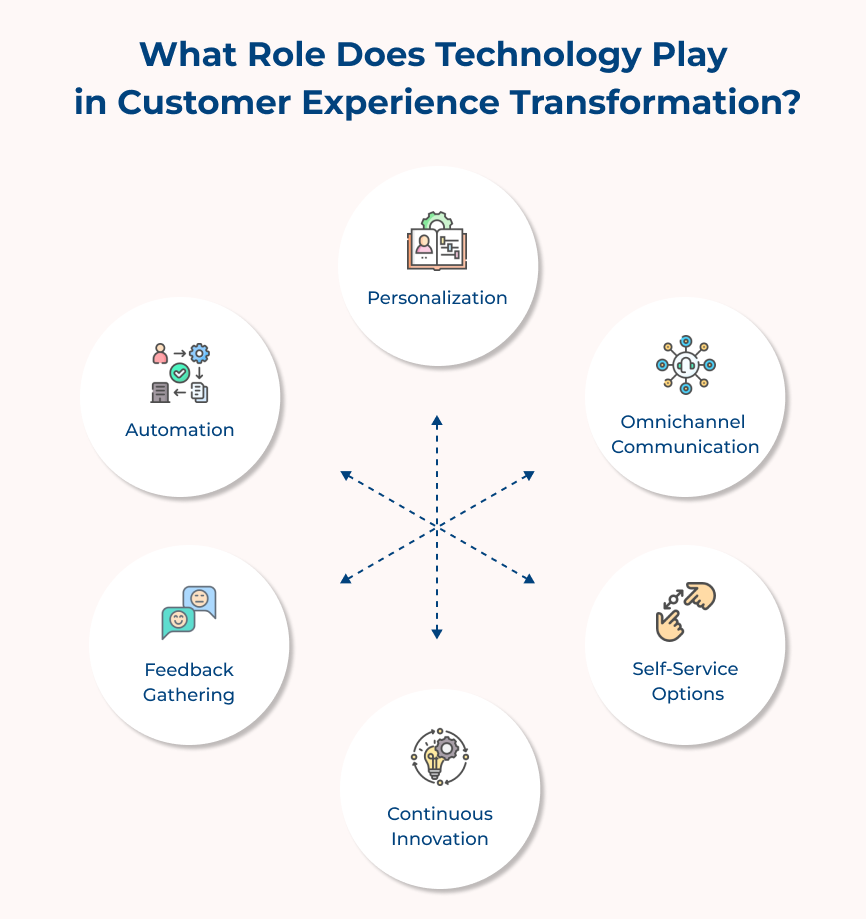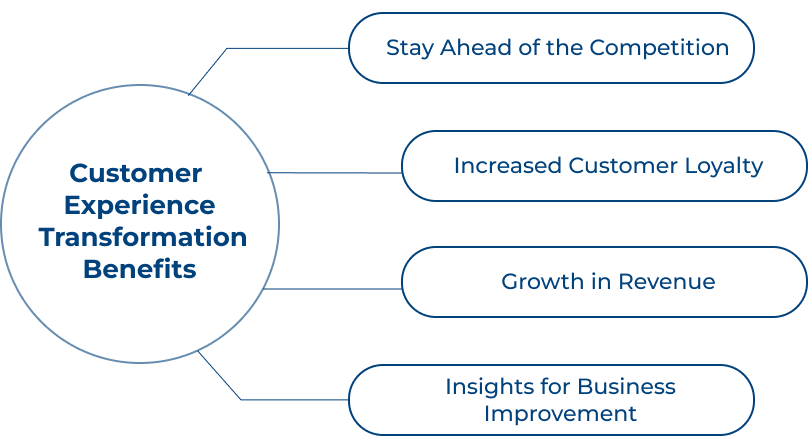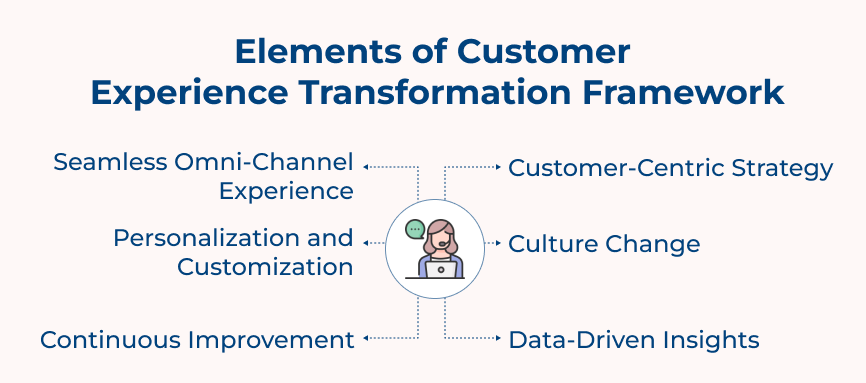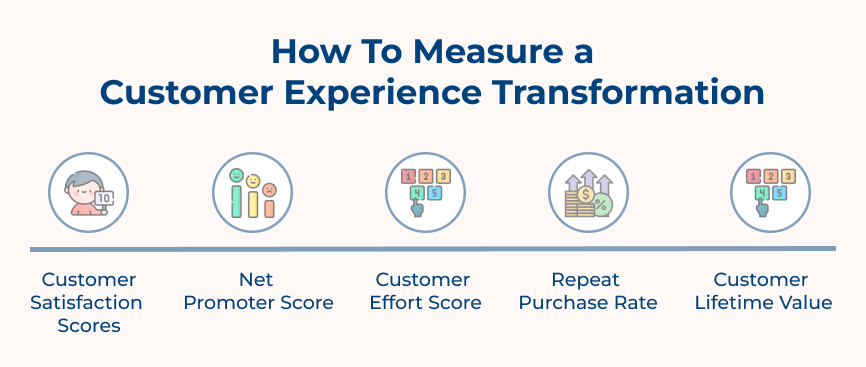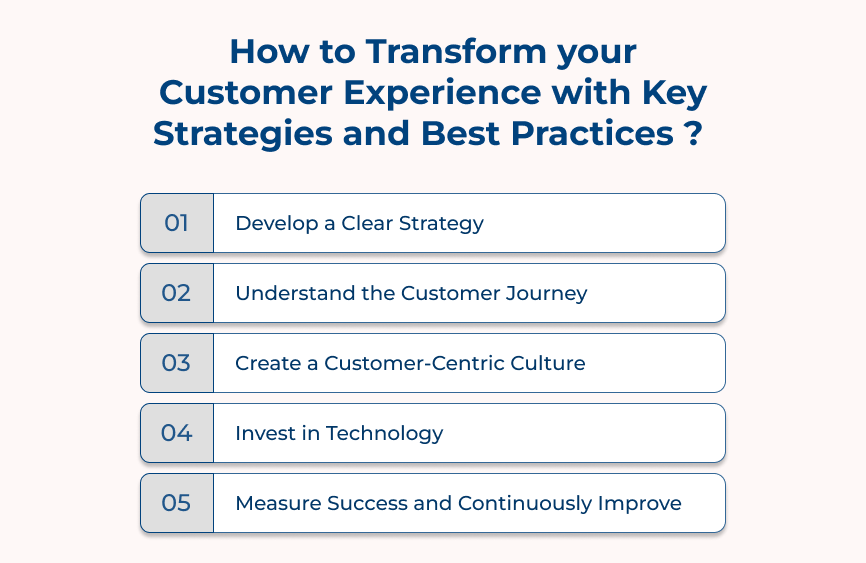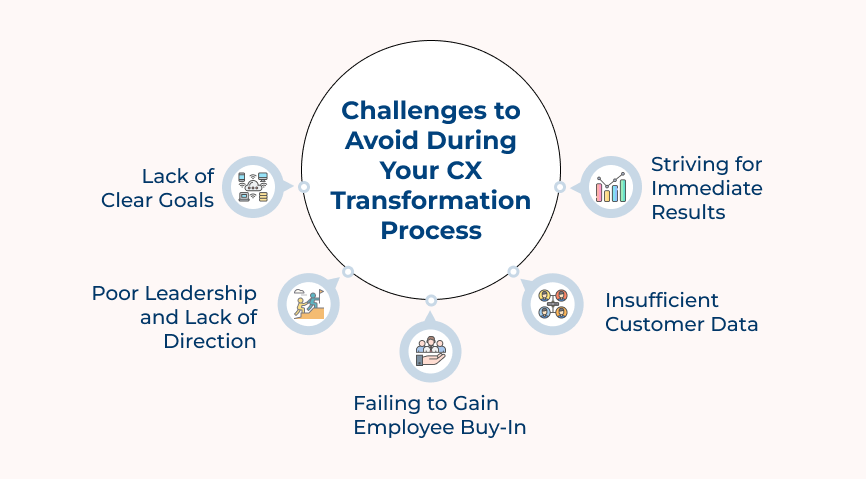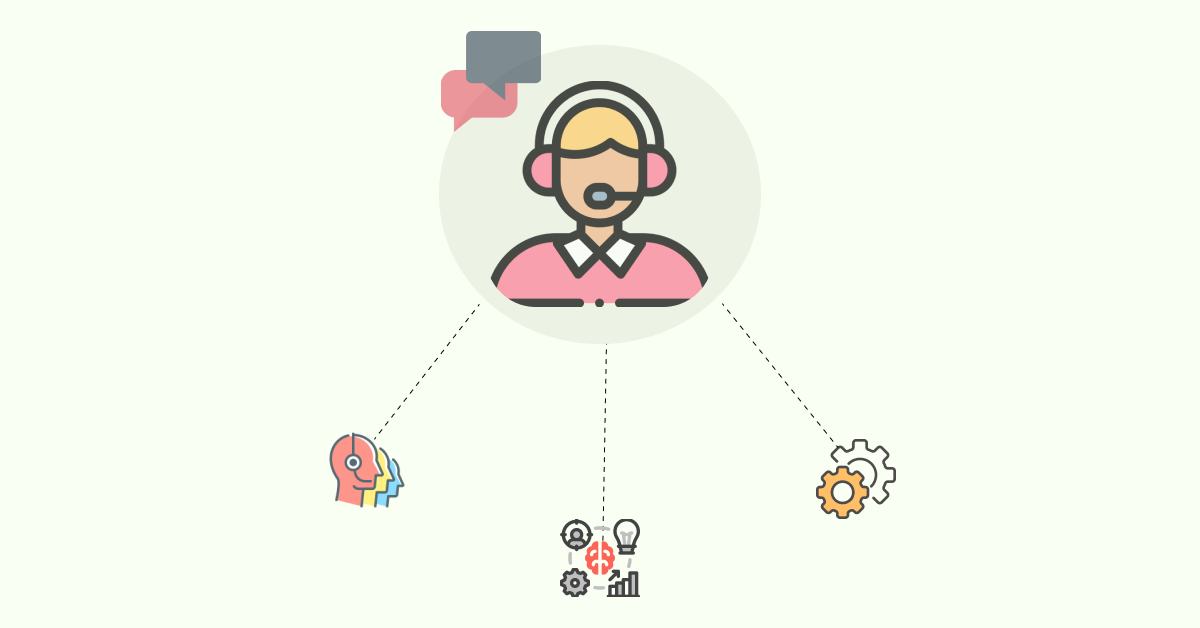1. Develop a Clear Strategy
Companies need a clear strategy that outlines the goals, target audience and the steps needed to take to achieve the objectives. It should include input from all levels of the organization from senior executives to front-line employees.
The leaders may also consider hiring a customer experience consultant. They will provide proficient assistance in laying out a clear plan and also guide the process.
Best Practices:
- Engage leadership: Ensure that senior executives are actively involved in shaping the customer experience strategy. Their buy-in and support are essential for successful implementation.
- Cross-functional collaboration: Encourage collaboration across different departments and teams within your organization. Ensure that everyone understands how their role contributes to the overall customer experience strategy.
- Regularly review and adjust: Recognize that customer expectations and market conditions can change. Schedule periodic reviews of your strategy to make necessary adjustments and remain aligned with your objectives.
2. Understand the Customer Journey
If the business wants to improve the customer experience it needs to fully understand the customer journey. It involves mapping out each touchpoint a customer has with your business, from their initial research to their final purchase decision.
Identify pain points, areas for improvement and opportunities to delight the customers. Make sure to develop a thorough understanding of the entire customer journey including all the touchpoints a user goes through while engaging with the business.
Best Practices:
- Customer feedback analysis: Collect and analyze feedback from customers at each touchpoint. Use surveys, reviews, and direct feedback to gain insights into pain points plus the areas for improvement.
- Customer personas: Create detailed customer personas to better understand your target audience. It helps in tailoring the customer journey to meet specific needs and preferences.
- User testing: Conduct usability testing to evaluate the ease of use and effectiveness of your digital touchpoints. Make iterative improvements based on user feedback.
3. Create a Customer-Centric Culture
Customer-centricity is at the heart of every successful customer experience transformation. It means putting the customer at the center of everything you do from product development to sales and support.
Leaders need to instill customer empathy across their company to create a customer-centric culture. It means training your employees to listen to customer feedback, understand customer needs and respond to customer issues quickly.
Best Practices:
- Employee training: Invest in training programs that emphasize the importance of customer-centricity. Teach employees active listening, problem-solving, and empathy skills.
- Recognition and rewards: Implement reward programs to acknowledge and incentivize employees who consistently demonstrate a customer-centric approach.
- Customer feedback loop: Establish a closed-loop feedback system where customer feedback directly influences decision-making and improvements across the organization.
4. Invest in Technology
Technology is a key enabler of customer experience transformation. Automating manual processes, implementing omnichannel support and utilizing customer data to personalize experiences are all important aspects of delivering exceptional customer experiences.
Identify the right technology solutions for your business needs. Make sure they are integrated with your existing systems and processes. Some of the tools companies typically go for are chatbots, social media management tools, Google Analytics, and Salesforce – all varying with the goals of the business.
Best Practices:
- Data analytics: Utilize advanced analytics to gain deeper insights into customer behavior and preferences. Use the insights to personalize marketing, product recommendations, and customer support.
- Omnichannel integration: Ensure seamless integration of customer interactions across various channels to provide consistent and convenient experiences.
- AI and automation: Implement AI-driven chatbots and automation tools to handle routine tasks. It frees up human agents to focus on complex customer issues and personalized interactions.
5. Measure Success and Continuously Improve
Companies have to measure the impact of the customer experience transformation to measure the progress and ensure they are on the right track. Set clear metrics and regularly track progress towards achieving them.
Use customer data to identify areas for improvement and adjust your strategy accordingly. Continuous improvement is key to delivering a positive customer experience so always be on the lookout for ways to enhance your processes and systems.
Best Practices:
- Key performance indicators (KPIs): Define and track KPIs that align with your customer experience goals, such as Net Promoter Score (NPS), Customer Satisfaction (CSAT), and Customer Effort Score (CES).
- Feedback analysis: Regularly analyze customer feedback, both positive and negative, to identify trends along with areas that require attention. Make sure to take swift action on critical issues.
- A/B testing: Implement A/B testing for website as well as app improvements to gauge the impact of changes on user satisfaction and conversion rates. Use the findings to optimize user experiences.
Example of Brands That Have Focused On Customer Experience Transformation
Here are five examples of brands that have successfully reimagined their customer journeys and delivered measurable improvements in user satisfaction:
1. Disney
Disney is a prime example of a brand that has successfully focused on customer experience transformation. Known for its magical theme parks, iconic characters and blockbuster movies, Disney has always put its customers first. In recent years, Disney has made significant efforts to enhance the customer experience across all its touchpoints.
The transformation has had a profound impact on Disney’s business, with increased customer loyalty, engagement and revenue. Disney has been able to attract new customers, retain existing ones, and drive growth in a highly competitive market. Running a successful customer-centric business requires you to put the customer at the center of their strategies to create lasting connections and drive success.
2. Amazon
Amazon is a household name that has become synonymous with convenience, selection and exceptional customer service. The e-commerce giant has transformed the customer experience landscape by focusing on providing a seamless shopping experience from start to finish. Amazon has personalized the shopping experience for each customer by using data analytics to recommend products based on past purchases and browsing history.
The focus on customer experience has had a massive impact on Amazon’s business, leading to increased customer loyalty, repeat purchases and positive word-of-mouth referrals. The company’s revenue and market share have continued to grow as a result of their commitment to putting the customer first.
3. Starbucks
Starbucks is a well-known coffeehouse chain that has become synonymous with quality coffee and a unique customer experience. The brand has successfully transformed its customer experience by focusing on creating a welcoming environment, personalized service and convenient mobile ordering options.
Other businesses can implement similar strategies by investing in customer service training, creating a consistent brand image and utilizing technology to enhance the customer experience. Focus on building relationships with customers while providing value beyond just products to differentiate yourself in a competitive market and drive long-term success.
4. Zappos
Zappos transformed customer experience by placing a strong emphasis on customer service and creating a company culture that prioritized the customer above all else. They implemented a 24/7 customer service hotline, free shipping both ways and a generous 365-day return policy. Zappos also encourages employees to go above and beyond for customers, leading to countless stories of exceptional customer service experiences.
The impact of this customer experience transformation was significant for Zappos. The company saw an increase in customer loyalty, repeat business and positive word-of-mouth marketing. This focus on customer satisfaction helped Zappos stand out in a competitive market and solidify its position as a leader in e-commerce.
Challenges to Avoid During Your CX Transformation Process
As businesses work to overhaul and improve their customer experience, they often encounter a range of complex challenges. Here are some of the most common obstacles that can arise during a CX transformation journey:






